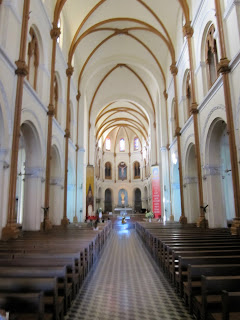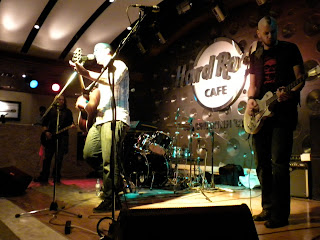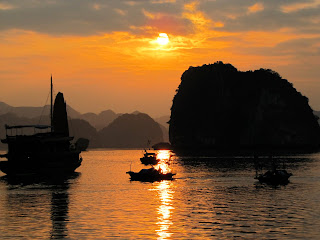After a terrific night, during which some of us enjoyed jamming with the band members of American Hitmen at the Hard Rock Café, we woke up grudgingly early and not quite ready to embark on a full day of business meetings. However, after about an hour nap on our bus ride to Phong Phu Corporation, we were refreshed and anxious for our meeting with the world acclaimed textile corporation.
Energized from our bus ride we finally made it to Phong Phu Corporation to meet with the Vice General Director, Mr. Pham Xuan Lap. Phong Phu Corporation, whose former name was Phongphu textile Company, was founded in 1964, known as the manufacturer of various kinds of textile and garment products such as towels, fabrics, yarns, sewing thread and garments for the latest years.
Together with the powerful economic development in the way of international integration, Phong Phu has gradually extended the main business and production structure of textiles and garments to areas such as finance, real estate business, infrastructure of industrial zones, trading centers, services, hotels.
With Phong Phu’s competitiveness based on consistent high quality, powerful capacity, proactive and professional services, they have exported successfully to United States, European Union, Japan, Korea and other Asian countries. In Home Textile area, they have developed successfully high quality towels and bathrobes. Additionally, they also manufacture garment products from casual wear, work wear to fashion wear like: pants, jacket, skirt, shirt, polo shirt and sweater in diversified designs, trimming and finishing decorated.
Phong Phu has joint-ventures with other local companies throughout Vietnam; thus, 10,000 employees work either directly and indirectly for Phong Phu. Besides the economic development, Phong Phu is the leading enterprise of Vinatex in constructing enterprise culture, paying much care of workers and community.
After listening to Mr. Lap share this information with us, we got the grand tour of the company. We saw firsthand the process that it takes to make the fabrics on our tour of the factory. As we walked through each section we were greeted by his friendly staff and shown beautiful towels and sheets. Much of the work that was done by hand verse machines. It made the tour more interesting to see the employees stich and sew together the fabrics.We also saw the finished products which were going to be imported to the United States.
Following our tour we said our goodbyes and headed to town to get some lunch. Surprisingly, our tour guide took us to a shopping center that had KFC in it. Many were delighted!
Once finished with lunch, we boarded the bus and headed off to Theodore Alexander, a fine furniture manufacturer with manufacturing and distributing facilities throughout the world. Our meeting began with a presentation given by Antony Smith, the president of Theodore Alexander. He introduced us to the history of the company, their operations worldwide, and their operations within Vietnam.
Paul Maitland Smith, a pioneer of the furniture industry in Southeast Asia, founded Theodore Alexander in 1996. The company acquired a plot of land in Linh Trung II, an export zone in Ho Chi Minh City, Vietnam. Since this area is its own “land” as far as customs is concerned, the area is duty free, a major money-saving advantage of having a major manufacturer within the zone. In this Vietnam location, Theodore Alexander has 660,000 square feet of manufacturing space, 80,000 square feet of warehouse, and 50,000 square feet of office space. The company employs 3,500 employees in Vietnam, but also implements small local manufacturers, providing another 1,000 workers.
One of Theodore Alexander’s primary initiatives is employee welfare. With regards to this area of interest, the company not only advocates adherence to international standards, but also goes above and beyond these standards. The facility is equipped with its own clinic and ambulance, follows strict health and safety procedures, undergoes quarterly audits, and has a near perfect safety record.
As mentioned previously, Theodore Alexander is profoundly involved in the global market. With 800 retailers in North America, the United States is the company’s largest market, but certainly not its only. Theodore Alexander has distributors in Spain, the UK, Russia, and South Africa and retailers in Southeast Asia, India, South America, and the Middle East.
The product line at Theodore Alexander consists of 4,000 different products, which include furniture, accessories, and lighting for all areas of the traditional home, with the sole exclusion of the bathroom. The products incorporate both traditional and transitional styles and are exclusively handcrafted. Although, in most cases, handcrafting can cost a lot more than using machinery, in the end a successful tradeoff is made: handcrafting differentiates the Theodore Alexander line as well as fulfills societal duties since it allows the company to employ many Vietnamese artisans. In fact, nearly all employees are local people as opposed to foreigners.
Theodore Alexander’s primary differentiator is the company’s breadth of home furnishings. The line includes a wide variety of product and styles. The furnishings are also composed of a plethora of different materials. The company’s primary competitors are Maitland Smith (a company previously owned by Paul Maitland Smith), Jonathon Charles, and Baker. Maitland Smith is the only of these competitors that comes close to having variety similar to the line by Theodore Alexander.
After listening to this information in Mr. Smith’s presentation, we were ready to see exactly how the manufacturing of these fabulous furnishings works. We split into three tour groups and each were led through the different divisions of the factory. The tour as a whole took near two hours, but we saw how each piece begins as a piece of timber, steel, veneer, or nearly any other building material, and is transformed into a beautiful piece of art and fine home décor.
Our experience at Theodore Alexander truly reflected the importance of innovation, quality, employee welfare, and marketing in maintaining a successful business. After being captivated by the work that goes into each furnishing and the beauty of the final product, I’m sure everyone fanaticized owning a piece by Theodore Alexander one day when we are all successful business men and women.
Theodore Alexander was our final scheduled event for the day, so most of us split up for a night on the town. Some headed off for Apocalypse, a trendy bar in the city, others went straight to sleep, and a large group of us were antsy for another round of Hard Rock. The Hard Rock was holding a red carpet event for its grand opening. The band scheduled for the event: Run DMC. Somehow, the reason is still beyond me, a large group of us were able to work our way into getting invites. We rocked the night away with Run DMC, American Hitmen, and our awesome professors.
By: Daishae' Pope and Kelsey O'Leary










































